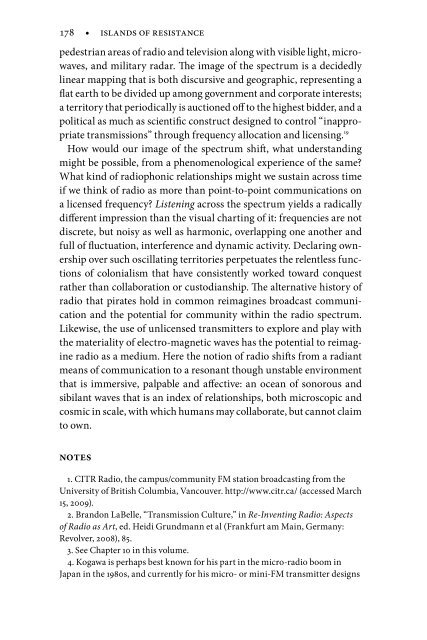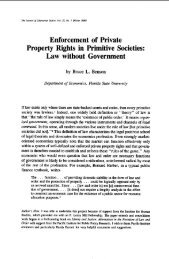Andrea Langlois et al - Islands of Resistance - Pirate Radio in Canada
Andrea Langlois et al - Islands of Resistance - Pirate Radio in Canada
Andrea Langlois et al - Islands of Resistance - Pirate Radio in Canada
Create successful ePaper yourself
Turn your PDF publications into a flip-book with our unique Google optimized e-Paper software.
178 • islands <strong>of</strong> resistance<br />
pedestrian areas <strong>of</strong> radio and television <strong>al</strong>ong with visible light, microwaves,<br />
and military radar. The image <strong>of</strong> the spectrum is a decidedly<br />
l<strong>in</strong>ear mapp<strong>in</strong>g that is both discursive and geographic, represent<strong>in</strong>g a<br />
flat earth to be divided up among government and corporate <strong>in</strong>terests;<br />
a territory that periodic<strong>al</strong>ly is auctioned <strong>of</strong>f to the highest bidder, and a<br />
politic<strong>al</strong> as much as scientific construct designed to control “<strong>in</strong>appropriate<br />
transmissions” through frequency <strong>al</strong>location and licens<strong>in</strong>g. 19<br />
How would our image <strong>of</strong> the spectrum shift, what understand<strong>in</strong>g<br />
might be possible, from a phenomenologic<strong>al</strong> experience <strong>of</strong> the same?<br />
What k<strong>in</strong>d <strong>of</strong> radiophonic relationships might we susta<strong>in</strong> across time<br />
if we th<strong>in</strong>k <strong>of</strong> radio as more than po<strong>in</strong>t-to-po<strong>in</strong>t communications on<br />
a licensed frequency? Listen<strong>in</strong>g across the spectrum yields a radic<strong>al</strong>ly<br />
different impression than the visu<strong>al</strong> chart<strong>in</strong>g <strong>of</strong> it: frequencies are not<br />
discr<strong>et</strong>e, but noisy as well as harmonic, overlapp<strong>in</strong>g one another and<br />
full <strong>of</strong> fluctuation, <strong>in</strong>terference and dynamic activity. Declar<strong>in</strong>g ownership<br />
over such oscillat<strong>in</strong>g territories perp<strong>et</strong>uates the relentless functions<br />
<strong>of</strong> coloni<strong>al</strong>ism that have consistently worked toward conquest<br />
rather than collaboration or custodianship. The <strong>al</strong>ternative history <strong>of</strong><br />
radio that pirates hold <strong>in</strong> common reimag<strong>in</strong>es broadcast communication<br />
and the potenti<strong>al</strong> for community with<strong>in</strong> the radio spectrum.<br />
Likewise, the use <strong>of</strong> unlicensed transmitters to explore and play with<br />
the materi<strong>al</strong>ity <strong>of</strong> electro-magn<strong>et</strong>ic waves has the potenti<strong>al</strong> to reimag<strong>in</strong>e<br />
radio as a medium. Here the notion <strong>of</strong> radio shifts from a radiant<br />
means <strong>of</strong> communication to a resonant though unstable environment<br />
that is immersive, p<strong>al</strong>pable and affective: an ocean <strong>of</strong> sonorous and<br />
sibilant waves that is an <strong>in</strong>dex <strong>of</strong> relationships, both microscopic and<br />
cosmic <strong>in</strong> sc<strong>al</strong>e, with which humans may collaborate, but cannot claim<br />
to own.<br />
notes<br />
1. CITR <strong>Radio</strong>, the campus/community FM station broadcast<strong>in</strong>g from the<br />
University <strong>of</strong> British Columbia, Vancouver. http://www.citr.ca/ (accessed March<br />
15, 2009).<br />
2. Brandon LaBelle, “Transmission Culture,” <strong>in</strong> Re-Invent<strong>in</strong>g <strong>Radio</strong>: Aspects<br />
<strong>of</strong> <strong>Radio</strong> as Art, ed. Heidi Grundmann <strong>et</strong> <strong>al</strong> (Frankfurt am Ma<strong>in</strong>, Germany:<br />
Revolver, 2008), 85.<br />
3. See Chapter 10 <strong>in</strong> this volume.<br />
4. Kogawa is perhaps best known for his part <strong>in</strong> the micro-radio boom <strong>in</strong><br />
Japan <strong>in</strong> the 1980s, and currently for his micro- or m<strong>in</strong>i-FM transmitter designs



